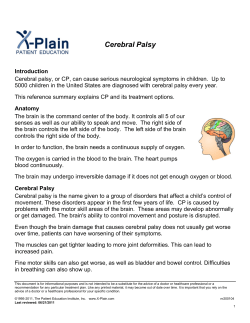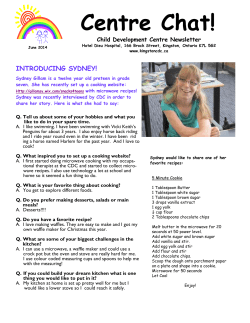
Document 63728
Hong Kong Journal of Emergency Medicine Bell's palsy in children: is there any role of steroid or acyclovir? D Doshi and M Saab We describe a case of a seven-year-old child with Bell's palsy who made a full recovery without the use of steroid or acyclovir. This is followed by a review of the literature to see whether or not there is any role of steroid or acyclovir in childhood Bell's palsy. (Hong Kong j.emerg.med. 2007;14:233-236) 7 Keywords: Bell palsy, child, facial paralysis, steroids Case report A seven-year-old girl was brought to the emergency department in December 2006 by her mother who had noticed facial asymmetry on the left side of her daughter's face. There was no history of trauma or preceding viral illness. She was unable to close her left eye completely. Her past medical histor y was unremarkable. Her father had similar weakness of his face when he was in his early twenties, which had recovered uneventfully. She had not travelled abroad in the recent past. Her physical and mental growth was normal for her age. She was not on any medication and her medical records were up to date for immunisations. On physical examination she appeared to be of moderate built and a happy child. Her tympanic Correspondence to: Deepak Doshi, MRCSEd(A&E), MRCS(Surgery) Manchester Royal Infirmary, Oxford Road, Manchester M13 9WL, United Kingdom Email: drdeepdoshi@yahoo.com Fairfield General Hospital, Rochdale Old Road, Bury BL9 7TD, United Kingdom Michael Saab, FCEM, FRCS temperature was normal. Pulse and blood pressure measurements were within the normal range for her age. The left side of her face was visibly drooped. Her left eye remained partially open even when she blinked. Her tympanic membranes were shiny pink in both ears and there was no cervical lymphadenopathy. Her tonsils were not inflamed. Facial nerve examination revealed that she had loss of nasolabial fold, inability to blow her cheeks, incomplete closure of eyelids and complete weakness on the left side of the face (Figures 1-4, with parent's permission). There was no loss of taste or sensation. Her higher function and the rest of the cranial nerve examination were normal. A clinical diagnosis of Bell's palsy was made. Artificial tear was prescribed. She was referred to the physiotherapist. She was not given any steroid or acyclovir. She was followed up regularly in the outpatient clinic for six months. She recovered completely without any residual weakness. Discussion Bell's palsy is defined as a lower motor neurone palsy of acute onset and idiopathic origin.1 Scottish surgeon- 234 Hong Kong j. emerg. med. Vol. 14(4) Oct 2007 Figure 1. Blowing cheeks. Figure 2. Smiling. Figure 3. Showing teeth. Figure 4. Closing eyes. anatomist Sir Charles Bell (1774-1842) described this as a syndrome of complete facial paralysis in a lecture 'On the nerves: giving an account of some experiments on their structure and functions, which lead to a new arrangement of the system' to the Royal Society of London in 1821. Almost a centur y later, the management and aetiology of Bell's palsy are still a subject of controversy.2 Bell's palsy is the commonest cause of facial palsy in children. Other causes of facial weakness in children include trauma (21%), ear infection (13%), congenital condition (8%) and neoplasia (2%).4 The true aetiology of Bell's palsy is unknown. The facial nerve passes through a narrow canal in the temporal bone before passing through a meatal foramen (about 0.66 mm in diameter).3 It is likely that any insult in the form of ischaemia, inflammation or demyelination can lead to facial nerve oedema and compression in this area. Bell's palsy occurs in 0.2% of the population with geographical variations, which is approximately 1 person in 65 in a lifetime. The incidence is slightly higher in persons of Japanese descent. The incidence is highest in persons aged 15-45 years of age. It affects both sexes equally. Children tend to recover well. There are no laboratory tests for confirmation of Bell's palsy. Persistent facial weakness warrants radiological and serological investigations to exclude neurological conditions like neuroma or Lyme disease. 5 Eye protection is of prime importance in Bell's palsy. Artificial tear solution protects the eye from exposure keratitis.6 Direct sunlight to the eye should be avoided by wearing ultraviolet light protection glasses. We s e a r c h e d t h e Me d l i n e , E M B A S E a n d t h e Cochrane Library databases to find evidence for the use of steroids or acyclovir in Bell's palsy − a benign self-limiting condition − in children. The results of our search are presented in a best evidence-based table format (Table 1). 7-14 Doshi et al./Bell's palsy in children 235 Table 1. Use of steroid or acyclovir in Bell's palsy Author, date Patient group Study type and country (Reference) Hato et al, 221 patients Prospective 2007, Japan (7) treatment within multicentre 7 days: randomised valaciclovir and controlled trial prednisolone (VP) compared to placebo and prednisolone (PP) Chen et al, 2005, 46 patients China (8) Acyclovir + prednisolone (AP) and prednisolone alone (P) group Dhiravibulya K, 75 children 2002, Thailand (9) 28 children − excluded 39 children − prednisolone 8 children − no treatment Unuvar et al, 42 children 1999, Turkey (12) Compared prednisolone to no treatment De Diego et al, 113 patients 1998, Spain (10) Adour et al, 1996, USA (11) Shafshak et al, 1994, Egypt (13) 119 patients Compared acyclovir with prednisolone (AP) to placebo and prednisolone (PP) 160 patients Prospective randomised controlled trial Outcome Key result Study weakness Yanagihara 40 point scoring system used VP group 96.5% recovery Small study Follow up for six months or until complete recovery PP group 89.7% recovery Recovery rate was better in the VP group Facial nerve function 91.3% (21 patients) Small study index recovered completely in AP group at four Placebo not compared weeks as compared to 78.3% in the P group Retrospective analysis Visual recovery Prospective randomised controlled study Recovery of facial palsy Prospective randomised controlled trial Prospective randomised controlled trial 107 patients Prednisolone vs. control All patients in No control both groups recovered completely Observational study at seven months Recovery not defined objectively All recovered at one year; in the treatment group 100% recovery at six months as compared to 86% at six months in the placebo group Visual assessment by Prednisolone was facial paralysis effective treatment recovery profile Facial paralysis recovery profile − visual assessment and electrical testing AP group had less partial nerve degeneration as compared to PP group (p=0.04) Clinical trial Facial nerve stimulation Steroids when given within 24 hours had better recovery Prospective randomised controlled study Functional nerve testing and time to recovery Prednisolone vs. control Austin et al, 1993, USA (14) Comparison with placebo alone would have measured the effectiveness of prednisolone Small study Adverse effects of steroid not mentioned Subjective recovery Small study 10.6% patients were lost to follow up 16.8% patients lost to follow up Small study Study was not blinded or randomised and some patients in the control group had contraindications for steroid use Significant 29% patients were lost improvement in to follow up after facial nerve function randomisation but no difference in recovery time in the steroid group Hong Kong j. emerg. med. Vol. 14(4) Oct 2007 236 Bell's palsy is not so common in children. Holland and Weiner concluded in a clinical review on recent developments in Bell's palsy that there was no supportive evidence for use of steroid or antiviral in children with Bell's palsy. 15 A systematic review by Salman and MacGregor in 2001 found no positive evidence for beneficial effects of steroid in Bell's palsy.16 There are very few trials done exclusively in children.17-19 Conclusion Bell's palsy is a self-limiting condition with a favourable prognosis. At present there is no evidence for the use of steroid or acyclovir. Prospective, well-designed randomised controlled trials are required to establish the efficacy of steroid, acyclovir or no treatment. 8. 9. 10. 11. 12. 13. References 14. 1. Lambert M. Bell palsy [Online]. [cited 2007 March 5]. Available from: http://www.emedicine.com/emerg/ topic56.htm 2. Anonymous. Bell's paralysis [Online]. [cited 2007 Aug 23]. Available from: http://www.whonamedit.com/ synd.cfm/2385.html 3. Warwick R, Williams PL. Facial nerve. In: Williams PL, editor. Gray's anatomy, 37th ed. Edinburgh: Churchill Livingstone; 1989. p. 1107-11. 4. May M, Fria TJ, Blumenthal F, Curtin H. Facial paralysis in children: differential diagnosis. Otolaryngol Head Neck Surg 1981;89(5):841-8. 5. Kannikeswaran N, Mahajan PV, Kamat D. Acute facial asymmetry. Clin Pediatr (Phila) 2006;45(3):289-92. 6. Singhi P, Jain V. Bell's palsy in children. Semin Pediatr Neurol 2003;10(4):289-97. 7. Hato N, Yamada H, Kohno H, Matsumoto S, Honda N, Gyo K, et al. Valacyclovir and prednisolone treatment for Bell's palsy: a multicenter, randomized, placebo-controlled study. Otol Neurotol 2007;28(3): 15. 16. 17. 18. 19. 408-13. Chen WL, Yang ZH, Huang ZQ. Outcome of treatment 46 patients with Bell's palsy with aciclovir and prednisone. Shanghai Kou Qiang Yi Xue 2005;14(6): 590-2. Dhiravibulya K. Outcome of Bell's palsy in children. J Med Assoc Thai 2002;85(3):334-9. De Diego JI, Prim MP, De Sarria MJ, Madero R, Gavilan J. Idiopathic facial paralysis: a randomized, prospective, and controlled study using single-dose prednisone versus acyclovir three times daily. Laryngoscope 1998;108(4 Pt 1):573-5. Adour KK, Ruboyianes JM, Von Doersten PG, Byl FM, Trent CS, Quesenberry CP Jr, et al. Bell's palsy treatment with acyclovir and prednisone compared with prednisone alone: a double-blind, randomized, controlled trial. Ann Otol Rhinol Laryngol 1996;105 (5):371-8. Unuvar E, Oguz F, Sidal M, Kilic A. Corticosteroid treatment of childhood Bell's palsy. Pediatr Neurol 1999;21(5):814-6. Shafshak TS, Essa AY, Bakey FA. The possible contributing factors for the success of steroid therapy in Bell's palsy: a clinical and electrophysiological study. J Laryngol Otol 1994;108(11):940-3. Austin JR, Peskind SP, Austin SG, Rice DH. Idiopathic facial nerve paralysis: a randomized double blind controlled study of placebo versus prednisone. Laryngoscope 1993;103(12):1326-33. Holland NJ, Weiner GM. Recent developments in Bell's palsy. BMJ 2004;329(7465):553-7. Salman MS, MacGregor DL. Should children with Bell's palsy be treated with corticosteroids? A systematic review. J Child Neurol 2001;16(8):565-8. Yuen M, Crawford I. Acyclovir was not shown to be effective in Bell's palsy [Online]. [cited 2002 Nov 13]; Available from: http://www.bestbets.org/cgi-bin/bets. pl?record=00248 Desmond J, Wallman P. Steroids only indicated for Bell's palsy with complete paralysis [Online]. [cited 2001 Apr 26]; Available from: http://www.bestbets.org/ cgi-bin/bets.pl?record=00084 Ashtekar CS, Joishy M, Joshi R. Do we need to give steroids in children with Bell's palsy? [Online]. [cited 2005 Apr 13]; Available from URL: http://www. bestbets.org/cgi-bin/bets.pl?record=00778
© Copyright 2025





















